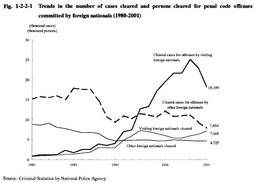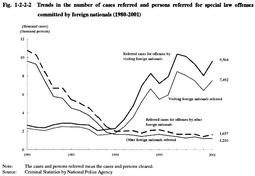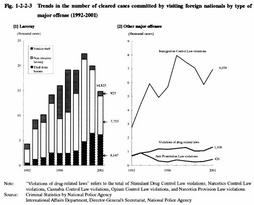| Previous Next Index Image Index Year Selection | |
|
|
2 Trends in crimes by visiting foreign nationals (1) Outline According to criminal statistics by the National Police Agency, concerning trends in the number of cases cleared and persons cleared for penal code offenses excluding professional negligence in traffic accidents (hereinafter referred to as "the number of cases cleared for penal code offenses" and "the number of persons cleared for penal code offenses" in this section) committed by foreign nationals since 1980, the number of cases cleared for penal code offenses committed by foreign nationals, which had exceeded 20,000 in 1986, took a downward turn in 1987. Then, it started rising again after 1990, reaching a record high of 36,382 in 1999. In 2000 and 2001, the number decreased for 2 consecutive years, to 26,093 in 2001.
The number of foreign nationals cleared for penal code offenses, which had stayed below 10,000 every year other than in 1982, has continued to exceed 10,000 since 1992. In 2001, the number increased by 930 (8.5%) from the previous year to 11,893 (see Appendix 1-8 ). The rate of foreign nationals to the total number of persons cleared for penal code offenses in Japan increased by 0.1% from the previous year to 3.7% in 2001. Fig. 1-2-2-1 shows the number of cases cleared and persons cleared for penal code offenses that were committed by foreign nationals since 1980 in terms of visiting foreign nationals and foreign nationals excluding visiting foreign nationals. Visiting foreign nationals have exceeded other foreign nationals excluding visiting foreign nationals in the number of persons cleared since 1991, in the number of cases cleared since 1993. In 2001, the number of cases cleared for penal code offenses that were committed by visiting foreign nationals decreased from the previous year, but the number of visiting foreign nationals cleared for penal code offenses increased from the previous year to 7,168 (the increase of 13.3% from the previous year). Fig. 1-2-2-2 shows the number of cases referred and persons referred for special law offenses excluding violations of traffic-related laws that have been committed by foreign nationals since 1980. The numbers of cases referred and persons referred, which had been generally decreasing from 1980 until 1990, has experienced an upward trend since 1991. In 2001, the number of cases referred increased by 1,783 (18.9%) to 11,221 from 9,438 in the previous year, and the number of persons referred also increased by 1,122 (14.8%) to 8,702 from 7,580 in the previous year (see Appendix 1-9 ). Fig. 1-2-2-1 Trends in the number of cases cleared and persons cleared for penal code offenses committed by foreign nationals (1980-2001) Fig. 1-2-2-2 Trends in the number of cases referred and persons referred for special law offenses committed by foreign nationals (1980-2001) Visiting foreign nationals exceeded other foreign nationals excluding visiting foreign nationals in the number of cases referred and persons referred in 1990, and have accounted for a majority of the cases and persons referred up to now.(2) Trends in offenses by type of offense Fig. 1-2-2-3 shows the trends in the number of cases cleared in the last 10 years for larceny, Immigration Control Law violations, violations of drug-related laws and Anti-Prostitution Law violations, which were committed by visiting foreign nationals. Larceny rose in 1993, and then took a downward turn after reaching a record high (22,404) in 1999. In 2001, it decreased by 5,129 (25.7%) to 14,823 from the previous year. In the index number regarding the number of cleared cases in 1992 as 100, the index in 2001 was 347. By modus operandi, non-invasive larceny has accounted for the majority of offenses each year, and vehicle theft was outstanding in the number of offenses from 1996 until 1998. Moreover, thefts from houses have remarkably increased since 1999, and reached 6,147 in 2001, accounting for 41.5% of the total number of larceny cases. Robberies increased in 2001 from the previous year, of which the numbers of cases cleared and persons cleared increased by 55 to 219, and by 73 to 309, respectively. (Source: Criminal Investigation Bureau, National Police Agency).
Immigration Control Law violations, which had been on a decreasing trend after a peak in 1997, increased again and reached 6,958 cases (5,808 persons) in 2001. In terms of type of offense, the numbers of cases cleared and persons cleared for illegal overstays reached the highest figures of 3,369 cases (2,884 persons), followed by 1,694 cases (1,377 persons) for the non-possession of passports or refusal to show passports, 1,011 cases (774 persons) for illegal stay, and 524 cases (419 persons) for illegal entry. In recent years, group stowaway incidents from China and other countries, in which international group stowaway agents such as "Snakeheads" are involved, have soared. The number of persons cleared by the police or Maritime Safety Agency for group stowaway incidents, which was 324 in 1995, rose to 679 in 1996, and 1,360 in 1997. Although the number fell sharply to 103 in 2000, it increased again to 419 in 2001. (Source: International Affairs Department, Director-General's Secretariat, National Police Agency). Additionally, when the Immigration Control and Refugee Recognition Act (hereinafter referred to as "the Immigration Control Law") was partially revised and came into force in May 1997, group stowaway-related offenses were newly established. The number of persons referred for group stowaway-related offenses was 38 in 1997, 153 in 1998, 142 in 1999, 29 in 2000, and 58 in 2001 (Source: Criminal Investigation Bureau, National Police Agency). Violations of drug-related laws rose in 1992, and reached 1,308 in 2001. Though having continued to increase by not more than 30% over previous years until 1993, the number of Anti-Prostitution Law violations fell sharply in 1994 after peaking in 1993, and since then have been generally decreasing. However, in 2001, the number rose by 146 (52.1%) from the previous year to 426. Fig. 1-2-2-3 Trends in the number of cleared cases committed by visiting foreign nationals by type of major offense (1992-2001) |


